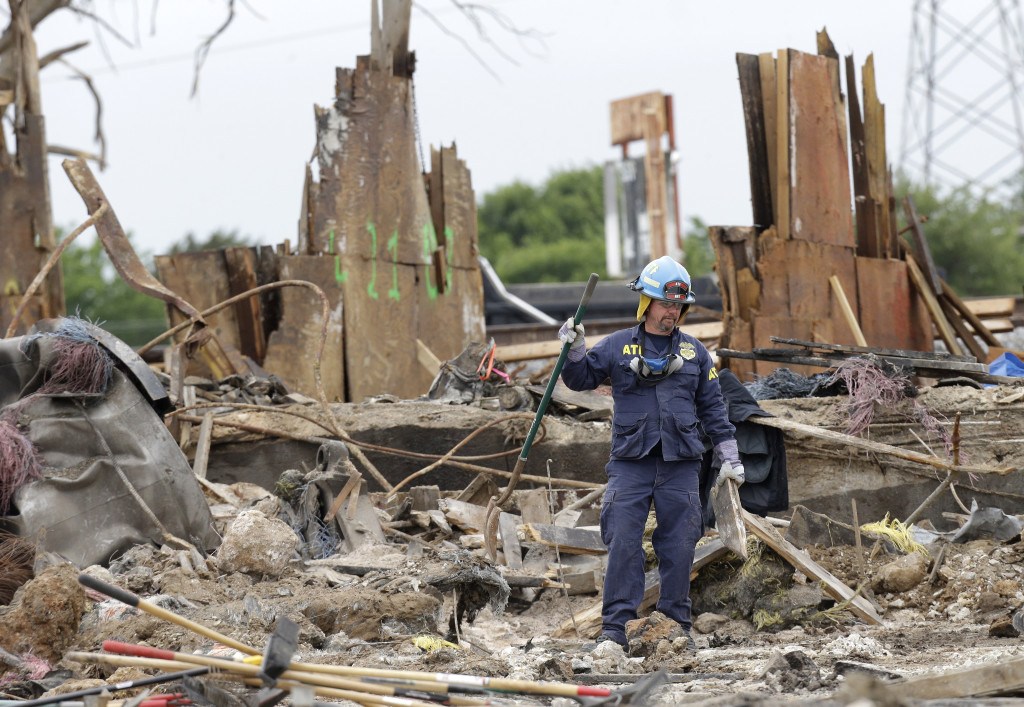The Trump administration’s move to relax an Obama-era chemical safety regulation put in place after an explosion at a fertilizer plant is the latest example of the White House easing rules established in the wake of disasters.
Trump’s professed goal of rolling back “job-killing” regulations has led to weakening mandates proposed or enacted after three of the worst industrial accidents of the last decade: The 2010 Deepwater Horizon oil spill in the Gulf of Mexico, the 2011 Fukushima nuclear plant meltdown in Japan and 2013 derailment and explosion of an oil train in Canada.
“There is a clear pattern of the Trump administration targeting rules that were put in place in response to massive public health, safety, and environmental disasters,” said Amit Narang, a regulatory policy expert with the watchdog group Public Citizen. “The public expects our government to respond to these types of public disasters with regulations that protect them.”
Backers of Trump’s drive to repeal rules say that there is a natural rush to regulate after a high-profile disaster that can go too far.
“Some of these rollbacks come with the wisdom of time to say ‘we went further then we needed to go now that we have more information,'” said Dan Bosch, director of regulatory policy for the American Action Forum, a Republican-aligned think tank.
Representatives of the White House reject the notion the rollbacks risk safety.
“Those trying to connect any health and safety risks across the country” to those efforts “are dangerously wrong — there is no evidence to support such ridiculous claims,” said Chase Jennings, a spokesman for the White House Office of Management and Budget. “The administration is focused on relieving undue burdens and protecting public health and safety.”
Still, the changes have set off alarm bells with public safety advocates.
“They have picked out some of the most important safety regulations,” said Fred Millar, an independent rail consultant. “The Trump deregulation bank has a withdrawal window that’s wide open and industry is taking advantage.”
In 2015, the U.S. Transportation Department imposed regulations meant to address a series of fiery crude-train derailments, most notably the one that killed 47 people in Lac-Megantic, Quebec. Canadian officials determined that a crew member’s failure to appropriately secure the train was one of nearly 20 causes of the derailment.
U.S. regulators mandated, over the objections of the industry, electronically controlled pnuematic brakes to shorten stopping distances. But that measure was rescinded by the Trump administration, which cited a lack of research showing the brakes were better and questions over whether the benefits were justified by the costs.
In some cases, the Obama rules have been left intact while some key provisions have been eased. That opens the administration to complaints it is rolling back safeguards even when it keeps many pieces untouched.
For example, the Environmental Protection Agency’s decision to rescind portions of a risk management law following the 2013 fertilizer explosion that killed 15 people in West, Texas, retained provisions cheered by safety advocates such mandating coordination with first responders and emergency exercise requirements.
But it axed mandates that required more public disclosure about what chemicals are stored at industrial sites, automatic third-party audits after accidents and a rule that companies assess safer technology options as a way of reducing risk.
That was also the case with the White House’s decision to relax some of the mandates imposed by the Obama administration in response to the Deepwater Horizon disaster that killed 11 workers and unleashed the worst oil spill in U.S. history.
In May, the Interior Department rewrote about a fifth of that 2016 Obama rule, easing mandates for real-time monitoring of offshore operations and third-party certifications of emergency equipment.
But the department rebuffed oil industry pressure to lift a specific requirement for how much pressure must be maintained inside wells to keep them in check. Instead, companies now can apply for exceptions to that “safe drilling margin” requirement earlier in the permitting process.
The Nuclear Regulatory Commission, with three of its five members Trump appointees, voted 3-2 in January to strip down a rule requiring nuclear plants to upgrade their protection against flooding and earthquakes that was meant to prevent a Fukushima-style meltdown from occurring in the U.S.
The nuclear industry argues that rather than redesign facilities to address increased flood risks, it’s enough to focus on storing emergency generators, pumps, and other equipment in concrete bunkers.
Edwin Lyman, acting director of the Nuclear Safety Project at the Union of Concerned Scientists, disagrees.
“It’s just bad science and bad policy because of the philosophy that we are not going to impose any new regulations,” Lyman said. “It’s dismissing science, it’s not taking into account the impact of climate change that could lead to more severe flooding events.”
–With assistance from Ryan Beene.
About the photo: An investigator pauses while sifting through the debris of the destroyed fertilizer plant in West, Texas, Thursday, May 2, 2013. Investigators face a slew of challenges in figuring out what caused the explosion at the fertilizer plant that killed 14 people and destroyed part of the small Texas town. (AP Photo/LM Otero, Pool)
Was this article valuable?
Here are more articles you may enjoy.


 Poorer Americans Dropped Federal Flood Insurance When Rates Rose
Poorer Americans Dropped Federal Flood Insurance When Rates Rose  Insurance AI Demo Day Calendar Announced
Insurance AI Demo Day Calendar Announced  NYT Asks Judge to Dismiss Trump’s ‘Implausible’ Defamation Suit
NYT Asks Judge to Dismiss Trump’s ‘Implausible’ Defamation Suit  Flooding in California Leads to Soaked Roads, Water Rescues and 1 Death
Flooding in California Leads to Soaked Roads, Water Rescues and 1 Death 